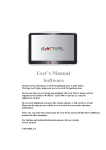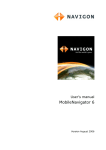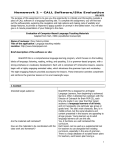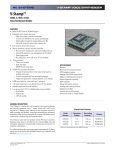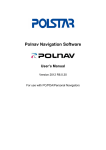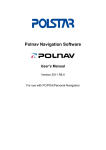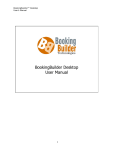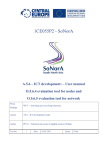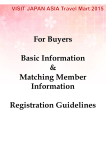Download Installing Content Manager
Transcript
User Manual Content Manager software for HP iPAQ 310 Series Travel Companion UK English Thursday, December 20, 2007 Part Number: 467721-001 Copyright note The product and the information contained herein is subject to change without prior notification. This manual may not, in whole or in part, be reproduced or transmitted in any form either electronically or mechanically, including photocopying and recording, without the express written consent of Hewlett-Packard Development Company, L.P.. © 2007 - Hewlett-Packard Development Company, L.P. All rights reserved. Microsoft, Windows, Vista, and Outlook are either registered trademarks or trademarks of Microsoft Corporation in the United States and/or other countries. 2 Table of contents Getting started with Content Manager ........................................................................................... 5 Installing Content Manager............................................................................................................. 6 Controls .......................................................................................................................................... 6 Menu bar .................................................................................................................................... 7 Toolbar icons.............................................................................................................................. 7 Operations window..................................................................................................................... 8 Information window .................................................................................................................... 8 Contents list................................................................................................................................ 8 Using Content Manager ................................................................................................................. 10 Starting and closing Content Manager ......................................................................................... 10 Selecting a device profile ......................................................................................................... 10 Recovery .................................................................................................................................. 10 Managing contents ....................................................................................................................... 10 Installing contents..................................................................................................................... 10 Removing contents................................................................................................................... 11 Updating contents .................................................................................................................... 11 Options and Tools.......................................................................................................................... 12 Transfer Trip Plans ....................................................................................................................... 12 Importing KML files................................................................................................................... 12 Backups ........................................................................................................................................ 12 Creating backups ..................................................................................................................... 12 Restoring backups.................................................................................................................... 13 Removing backups................................................................................................................... 13 Device profiles .............................................................................................................................. 13 Removing device profiles ......................................................................................................... 13 Editing device profiles .............................................................................................................. 13 Contacts synchronization.............................................................................................................. 14 Preferences .................................................................................................................................. 14 General..................................................................................................................................... 14 Visualization ............................................................................................................................. 15 Customising table fonts ....................................................................................................... 15 Customising table colours.................................................................................................... 15 Uninstalling Content Manager ...................................................................................................... 16 3 4 Getting started with Content Manager Content Manager is a PC based application that has a number of important features to help you manage the content of your HP iPAQ 310 Series Travel Companion. With Content Manager you can: • Backup the content stored on your device to your PC and restore it back to your device later. • Connect to the Content Manager server to download updates or additional navigation content on your device. • Synchronize Microsoft Outlook Contacts to your device. • Transfer trip plans created on www.ipaq.com to your device. There are several types of navigation content that are loaded on your device and that can be used with Content Manager. The content that is available depends on the device you originally purchased and the country you purchased it from. Content is broken down into smaller, more manageable pieces for each region or country. The various types of content that might be available include: • Maps are the road networks used by the navigation system to route your trips. • Landmarks are 3D artistic or block representations of prominent or well-known objects. 3D landmarks are only available in selected cities and countries. • 3D Cities are full 3D city building data that represents actual building size and position on the map. 3D cities building data is limited to the city centre of major cities in the US and Europe. • POIs are Points of Interest, which are specific reference points that can be searched and navigated to. They are sorted into different categories like hotels, restaurants, tourist attractions, banks and many other locations users may want to find while they travel. • Phonemes are used by the Text to Speech navigation engine to announce the road names during navigation. Text to Speech voices are not available for all languages and can be set on your Travel Companion by selecting any voice profile with '(TTS)' in its name. • Relief is the 3D terrain map data that shows changes in terrain, elevations or depressions in the land when you view the map, and use it to plot the route map in 3D when you navigate. • Voice language is the voice profile used for navigation guidance. These are either prerecorded voices or Text to Speech voices. Text to Speech voice profiles are indicated by '(TTS)' and use artificial intelligence to announce road names during navigation. Non Text to Speech voices are recorded in the identified language and just tell the user to turn left or right and at what distance. • Menu language is a list of available languages for the device software to display button labels and screen messages. • Application is the navigation software that is running on your Travel Companion. 5 System requirements To use Content Manager, you need a USB cable and a computer that meets the following minimum specifications. To access the Content Manager server, you also need an active Internet connection on your PC. To use the contacts synchronization feature, Microsoft Outlook 2003 or a later version needs to be installed on your PC. Minimum Recommended Operating system Windows XP Windows Vista Processor 300 MHz clock speed Intel Pentium/Celeron family, or AMD K6/Athlon/Duron family, or compatible processor System memory 256 MB 512 MB Free disk space 2 GB 5 GB NOTE: In order to install new contents on your HP iPAQ Travel Companion, you need an active Internet connection on your PC! Installing Content Manager Follow these steps to install Content Manager on your computer: 1. Visit www.ipaq.com to download the latest Content Manager to your PC. 2. Download the file to your PC and run the installer. 3. Select a language from the list, then click OK. 4. Review the license agreement. If you want to continue, click I Agree. 5. Select the installation folder. A default installation folder is already given: C:\Program Files\Hewlett-Packard\HP iPAQ Travel Companion 310 Series To choose a different folder, type in the path name, or click Browse, and select a different folder. 6. Click Install to start the copying process. To see the details during copying, click Show Details. 7. Click Next to continue. 8. (optional) To start Content Manager right after the installation, tick the checkbox. 9. The installation is complete, click Close to exit. Content Manager has an auto-updating feature to ensure you always have the most up-to-date version on your PC. Each time you launch the application, it checks for available updates. Controls The main window of Content Manager is divided into the following sections: 6 • the menu bar • the toolbar icons • the Contents list, all content items available for the connected device • the Operations window • the Information window Menu bar The Menu bar contains the following submenus: • File: • • • • • Exit: Quits Content Manager. Content (content related actions): • Install: Installs the selected contents on the device. • Install all: Installs all available contents on the device. • Update: Updates the selected contents on the device. • Update all: Updates all contents on the device. • Remove: Removes the selected contents from the device. Operation (operation related actions): • Perform operations: Executes all content operations listed in the Operations window. • Remove operation: Cancels the selected content operations. • Clear operations: Cancels all content operations listed in the Operations window. • Transfer Trip Plans: Launches the Manage Trip Plans screen to transfer trip plans created on www.ipaq.com from your PC to your device, or from your device to your PC. • Backups: Launches the Manage backups screen to create a backup or recover one to your device. • Device Profiles: Lets you edit and remove the device profiles you have created. • Contact Synchronization: Launches the Microsoft Outlook synchronization feature. • Preferences: Lets you manage preferences available for Content Manager. Tools: Help: Displays help information. Toolbar icons The icons under the menu bar perform the same actions as the menu items in the Content and Operation menus. Icon Menu Item Function Content > Install Installs the selected contents on the device. Content > Update Updates the selected contents on the device. Content > Remove Removes the selected contents from the device. 7 Icon Menu Item Function Content > Install all Installs all available contents on the device. Content > Update all Updates all contents on the device. Operation > Perform operations Executes all content operations listed in the Operations window. Operation > Remove operation Cancels the selected content operations. Operation > Clear operations Cancels all content operations listed in the Operations window. Operations window After selecting an action, it appears in the Operations window. The name, type and size of the content are displayed here together with the assigned action. All the content operations in the Operations window can be performed by clicking the Operation menu. , or by clicking Perform operations in Information window This window displays information about the connected device. The following parameters are shown: • The name of the device. • The memory type (for example: 'Flash'). • The Before column displays the current amount of free storage space. • The After column displays the amount of free storage space after performing the currently selected operations. • The Capacity column displays the total amount of storage space. Contents list The largest part of Content Manager is the list of content elements available for the connected device. The columns of the list are as follows: • The name of the content. This column can also include icons which show the status of that specific content: Icon Function This content is not installed yet. This content can be updated. No icon This content is installed and up-to-date. • The type of content. • The next column indicates whether the content was installed. It also displays the amount of storage space needed to install this content element. There are three menu items to filter the Contents list: status, type and position. 8 • Status: Filters contents based on their status: • All: Displays all contents. • Installed: Displays only contents installed on the device. • Not installed: Displays only available contents that are not installed on the device. • Updatable: Displays contents that have a newer version than the one installed. • Updatable or not installed: Displays all contents that are not installed or updatable. • Up-to-date: Displays all installed and up-to-date contents. • Type: Filters contents based on their type. • Location: Filters contents based on their storage location. 9 Using Content Manager Starting and closing Content Manager To start Content Manager, do the following: 1. Click Start > All Programs. 2. Select HP iPAQ Travel Companion 310 Series. 3. Click Content Manager. To close Content Manager, click File > Exit. Selecting a device profile The device profile screen appears before startup. Use the default profile name, or enter a new name for the connected device. Every time you start Content Manager with a new device, a different device profile needs to be created. Recovery To overwrite the content of your device with a previously saved backup, do the following: 1. Click Recovery. 2. Select a profile name and a device type. 3. Select the backup and the device drive. 4. Click Start to begin the recovery. NOTE: In order to perform a recovery, you need a full backup. Creating a full backup is recommended when you start using your device. Managing contents Installing contents NOTE: Only non-installed contents can be installed. They have an in the Contents list. To upload the selected contents to the device, do the following: 1. Select the content items from the Contents list. There are several ways to do this: • Click on a content item in the Contents list. To select multiple items, use either the Shift or the Ctrl key. Click Install in the Content menu or click 10 icon next to their name • Drag-and-drop the content items to the Operations window. • Double-click a content item. in the toolbar. 2. Execute the actions by clicking Perform operations in the Operation menu or by clicking in the toolbar. 3. Confirm the installation by clicking Yes. 4. Click OK when the process is finished. Removing contents NOTE: Only installed contents can be removed. To remove selected content elements, do the following: 1. Click on a content item in the Contents list. To select multiple items, use either the Shift or the Ctrl key. 2. Click Remove in the Content menu, click selected contents and click Remove. 3. Execute the actions by clicking Perform operations in the Operation menu or by clicking in the toolbar, or right-click on the in the toolbar. 4. Select Yes from the popup box. 5. Click OK when the process is finished. Updating contents NOTE: Only non-up-to-date contents can be updated. Non-up-to-date contents have an icon next to their name in the Contents list. To update the selected contents, perform the following steps: 1. Select the content items from the Contents list. There are several ways to do this: • Click on a content item in the Contents list. To select multiple items, use either the Shift or the Ctrl key. Click Update in the Content menu or click in the toolbar. • Drag-and-drop the content items to the Operations window. • Double-click a content item. 2. Execute the actions by clicking Perform operations in the Operation menu or by clicking 3. in the toolbar. Click OK when the process is finished. 11 Options and Tools The tools and options in Content Manager can be accessed in the Tools menu. Transfer Trip Plans Visit www.ipaq.com to learn about the trip planning services available for your HP iPAQ Travel Companion. There you can create custom itineraries that can be transferred to your device to navigate with. You can use Content Manager to transfer trip plans that you create. Trip plans can be transferred to your device as Routes and as POIs. Importing KML files 1. Create a trip plan on www.ipaq.com. 2. Save the trip plan to your PC. 3. Connect your Travel Companion to your PC and launch Content Manager. 4. Under Tools, select Transfer Trip Plans. 5. You can select Import as Route, or Import as POI: • Import as Route moves the trip plan to the Nav Extras section on your Travel Companion. There you can select the trip plan and use the device to navigate according to it. • Import as POI moves the route points of the trip plan into the POI database on your device. They can be searched and used to navigate with, just like the pre-installed POIs. 6. Select the trip plan stored on your PC to have it transferred to your device. Backups You can make a duplicate copy of the device contents and store it on your PC. Backups are helpful to have as a safety precaution if you unintentionally delete content off your device. You always have license to the content that you purchased with your device and can use Content Manager to re-download this at any time. Backups are helpful to save the time of downloads or if your PC is not connected to the Internet. Creating backups To backup your data, do the following: 12 1. Select Backup from the Tools menu to open the Manage backups window. 2. Click on Backup in the Manage backups window, then select Backup. 3. Use the radio buttons to select the data to save: • full backup • backup user data only • backup user contacts only 4. The default backup folder is displayed. To define a different one, click I want to define a folder manually, and then enter the path of the desired location, or click Browse and select the folder. 5. Click OK to start the backup process. 6. Click OK when the process is finished. Restoring backups To restore backed up data, do the following: 1. Select Backup from the Tools menu to open the Manage backups window. 2. Select a previously saved backup from the list. 3. Click Restore. 4. Click Yes to start restoring your data. 5. Click OK when the process is finished. Removing backups To remove backed up data, do the following: 1. Select Backup from the Tools menu to open the Manage backups window. 2. Select a previously saved backup from the list. 3. Click Remove. 4. Click Yes to delete the backup. Device profiles Existing device profiles can be edited and removed in the Device profiles menu. The current device profile is displayed in bold. NOTE: New device profiles can only be created when you start Content Manager with a new device connected. Removing device profiles To remove a device profile, do the following: 1. Select Device profiles from the Tools menu. 2. Click on the device profile you want to remove. 3. Click Remove. 4. Click Yes to proceed with deleting the selected device profile. NOTE: The currently used profile cannot be deleted. Editing device profiles To edit a device profile, do the following: 1. Select Device profiles from the Tools menu. 2. Click on the device profile you want to edit. 3. Click Edit. 4. Modify the profile parameters: 13 • To change the name of the profile, enter the desired profile name. • To change the type of the device, select the appropriate device type from the list of available device types. 5. Click OK to confirm the changes. Contacts synchronization You can use Content Manager to synchronize the contacts stored in Microsoft Outlook with the contacts database on your device. If these contacts have addresses associated, you can use these addresses as navigation points. If these contacts have phone numbers associated with them, they can be called using the Bluetooth handsfree phone feature of your Travel Companion. A Bluetooth phone must be paired with your Travel Companion to use this feature. To synchronize contacts: 1. Select Contacts Synchronization from the Tools menu. 2. Click Sync to synchronize contacts with your device. 3. Click Settings to modify how you sync, how conflicts are managed and to set the automatic synchronization. A conflict takes place when a contact's data is different on your PC and on your device. Conflicts can be handled in the following ways: • PC overwrites Device gives priority to the contact data on the PC, and this is what is copied to your device. • Device overwrites PC gives priority to the contact data on your device, and this is what is copied to your PC. • Ask me allows the user to select which contact overwrites the other. Select Start with Windows and Outlook Sync will automatically start during Windows startup. Select Synchronize automatically to make Outlook Sync automatically synchronize contacts when the device is connected. Preferences Settings can be configured in the Preferences menu. Settings are displayed on the following tabs: • General • Visualization General The General preferences window has the following sections: 14 • Language: The language of Content Manager can be changed by selecting a language from the drop-down menu. • Mouse wheel speed: The mouse wheel speed in the Contents list can be changed by moving the slider to the desired position. • Local storage folder: When a content item is installed on the device, the content item is also saved in a folder on the computer. This folder can be changed here by clicking Browse and selecting a different folder. If you want to use to default folder again, click Reset. • Cache: The overall size of all content items stored in your computer is displayed. The local storage folder can be emptied by clicking Clear. If a content item is stored in the local storage folder, it can be installed on a device without an Internet connection. NOTE: The changes take effect only after clicking OK. Visualization You can set customised fonts and colours for the Contents list. Customising table fonts To change table fonts, do the following: 1. Enable custom fonts by ticking Enable customised fonts in tables. 2. Click Font. 3. Select the desired font and click OK. Customising table colours You can define custom foreground and background colours for the different content types. By choosing custom table colours, content types are easier to distinguish. To change table colours, do the following: 1. Enable customised table colours by ticking Enable customised colours in tables. 2. Click on the button next to a content type in the foreground or the background column. 3. Select the desired colour. NOTE: The changes take effect only after clicking OK. 15 Uninstalling Content Manager To uninstall Content Manager, do the following: 16 1. Select Start > Control Panel on your PC. 2. Double-click Add or Remove Programs. 3. Select HP iPAQ Travel Companion 310 Series Content Manager. 4. Click Change/Remove. 5. Click Uninstall. To see the details during the process, click Show Details. 6. Click Close to exit when the process is finished.

















